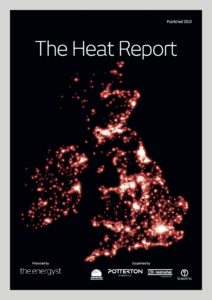
Decarbonising direct electric heat across an estate spanning 136 buildings in 26 cities is no mean feat. But Unite Students energy & environment manager James Tiernan sees it as an opportunity to test a range of technologies and approaches. He has already dispelled some preconceptions.
Tiernan looks after the energy needs of 46,000 students across the UK. The estate spans 136 buildings in 26 cities, from Aberdeen down to Plymouth. Buildings vary significantly in design, age, construction type and approach to building services. Unite’s new build pipeline also encompasses a range of strategies.
“It’s quite a complex mix,” admits Tiernan. But it means he can assess pretty much every technology in a bid to boost efficiency and reduce carbon emissions.
Direct electric
Despite the variables, there is one near universal theme.
“The biggest chunk in our existing estate for heating and hot water is direct electric. Which obviously poses quite a few challenges from an energy and carbon point of view,” says Tiernan.
“So the focus has been twofold: What is the best way of generating heat, whether space heating or hot water; and what is the best way of controlling it, specific to our requirements.”
Unknown knowns

The tricky part is that those requirements are unpredictable.
“There isn’t really a usage pattern. Students don’t have one. It really is quite difficult to predict when demand is going to be there for heating and hot water. That’s also true at a micro and macro level: Within the day, but also from day-to-day, week-to-week, month-to-month. “
The third week in March, for example, is not always Reading Week and Easter. Also, students from one discipline might spend more time in lectures while others spend more time in halls. The only certainty, says Tiernan, is the summer holidays.
“Even then there are still hot water requirements for cleaning. Many of our buildings maintain water hygiene via temperature control, so you have to keep the cylinders above a certain temperature, otherwise they have to be reconditioned and purged. That is just not possible in the timescales that we have to turn the rooms around.”
Ultimately Tiernan wants to move the estate away from direct electric heating. But that may take years and such narrow windows of opportunity make improving existing assets enough of a challenge. Hence making controls a priority.
He hopes those controls will also allow the company to participate in demand-side services and Triad management, and has begun discussions with aggregators.
Demand-side response
“Electric immersion heaters are a prime candidate for demand-side management (DSM) both in terms of switching off and turning on,” says Tiernan. “In the long term I am keen to replace them with something far more efficient than direct electric. But if in the short term we can achieve some real benefits through changing the controller relatively easily, we are keen to do so.”
What complicates the picture, compared to other sectors, says Tiernan, is that instead of having buildings with several large point loads, Unite has the opposite.
“Our buildings have many, many distributed small loads. That makes it difficult to cost effectively manage them – and that applies to DSM as much as anything else. So if we do go down the DSM route, we must have cost effective controls.”
He is upbeat that can be achieved given the explosion of connectivity and the burgeoning internet of things. Unite is working with suppliers to keep costs down.
“The moment you get above £100 per controller, with 46,000 rooms it starts to get very expensive. The business case then starts to look slightly less favourable. But as technology develops there will be more that we can look at doing.”
Infrared and heat pumps
Tiernan says “next level” trials with direct electric sites aim to gauge whether existing basic panel heaters might be improved upon.
“We are trialing forced air convectors, infra-red panel heaters, oil filled radiators and other technology to work out what is the best way of getting the heat into the room, and then controlling it,” he says.
“We also have various pilots and trials running at the moment looking at the best retrofit approach as well. So where we have got distributed direct electric hot water throughout the building, we are looking at a pilot to see if we can retrofit those with centralised air source heat pumps.”
That trial is taking place at a site that uses a gas boiler because it will provide back-up during the install. Tiernan says the need to provide continuous user comfort with no margin for error throws up another project skew.
“It is not like a hotel where you can take rooms offline for a week – even though there are time pressures there and I appreciate that – our rooms are occupied all year round apart from a small window in the summer. Our students are very much seen as customers. A central pillar of our service is providin a safe, secure, comfortable place to live. So we are trying to balance customer comfort versus energy savings.”
District heating
Beyond that, Unite has even bigger plans, aiming to connect to a heat network in Aberdeen, although Tiernan admits he still has to write the business case. Retrofitting a wet heating system to a currently all-electric building is no mean feat, and he acknowledges that business case “will have to be quite compelling”.
But he thinks the project looks viable because it will connect to an existing network, removing the cost of a central plant. And as Tiernan looks to move away from direct electric via wet-system retrofits, the project may well “kill two birds with one stone”.
“It will prove the concept of district heating retrofit, but it will also prove the concept for wet heating retrofit, so we can then look whether we use CHP, condensing boilers, heat pumps or whatever, “ he says. “It becomes almost academic.”
Finance
Tiernan says Unite tends to use its own capital to fund projects, tending to steer clear of external finance. Sometimes those projects are significant.
“We are halfway through a £21million LED lighting and controls upgrade, which was fully funded with internal capital. We don’t have any EPC-type arrangements and we are not actively looking at any.
EPCs may work in certain environments, he says, “but with our estate and structures they don’t work so well and can perhaps be a bit constraining.”
Unite, he says, has to put customer comfort first.
“Anything that could potentially jeopardise that is too high a risk. The risk is that someone is incentivised by the savings they achieve, not necessarily the customer satisfaction that results.”
 Subsidies
Subsidies
Equally, subsidies are not high on the agenda. Tiernan suggests that in the main they are too complex and create unnecessary risk.
“There was an Eco stream specifically for retrofit connections for district heating. Initially, we thought that looked brilliant.” But scratching the surface proved otherwise.
“There are so many hoops to jump through along the way. Because it is retrospectively applied, the risk is that if you predicate your business case on the funding, and you don’t actually get it, it is just too high a risk. Plus you have to have bridging funds in the interim anyway.”
If projects actually manage to get support “it is almost like a bonus,” says Tiernan. “In which case you don’t need it anyway because you have already had to write a viable business case. So it is almost irrelevant.
The way we see it, something is cost effective and viable, or it is not. So we have to build a business case that stands on its own two feet.”
Certainty?
That’s not to say any guaranteed incentive would not be factored into projects. But Tiernan questions whether certainty actually exists within energy policy, with one of the most recent u-turns proving his point.
“Historically we have looked at the carbon benefits that would be delivered and therefore the CRC savings that would be realised. That acted as an incentive to be within the business case because it was relatively certain. But, nothing is really certain and a few years from now we are going to lose that element of the business case due to the CRC’s demise.”
While admitting it is hardly an original thought, Tiernan says the only policy he can think of that would help decarbonise heat more quickly is certainty.
“Chopping and changing doesn’t help anyone in any area of life. So if you are planning any major investment you have to make sure it can stand on its own two feet should the carpet be pulled out from under them.”
A surprise outcome on electric heat’s carbon emissions
Tiernan says that while he was “almost ideologically opposed” to using electricity for heating, running the numbers from this year’s carbon calculations challenged his assumptions.
“The sites where we have direct electric heating and direct electric hot water actually performed pretty well from a carbon point of view compared to sites where we have gas,” he says. “That is down to the fact it is much easier to control the electric sites and therefore you are not wasting heat in empty rooms.”
“I found it interesting that my initial view [of direct electric] proved to be not necessarily the full picture.”
This article was originally published in Energyst Media’s 2016 Heat Report. The report contains a survey of readers’ heat priorities, the technologies they are assessing or investing in, and their views on heat policy. It also contains in-depth interviews with financiers, academics and consultants. Download it here, free of charge.
Related stories:
Free download: The Heat Report 2016
The heat is on, but which technologies will decarbonise heat at lowest cost?
Local Authorities must improve scoping to get heat networks funded
Government ‘has heat network numbers wrong’
Heatpumps, biomass and CHP top firms’ heat investments for 2016
Can Epsom salts solve heat storage conundrum?
Waste heat a wasted opportunity
75p/kWh subsidies for district heating?
Brussels increases focus on energy efficient heating and cooling
Decentralisation the key to heat networks?
Tim Rotheray: Put users at heart of energy policy or watch it fail
CHP behind 6% of UK electricity, could do more
Councils step up heat network plans
Firms with CHP generators could be paid to stop exporting power
Local Authorities say finance and public procurement biggest barrier to heat networks
Free report: Financing energy efficiency
Click here to see if you qualify for a free subscription to the print magazine, or to renew.
Follow us at @EnergystMedia. For regular bulletins, sign up for the free newsletter.



